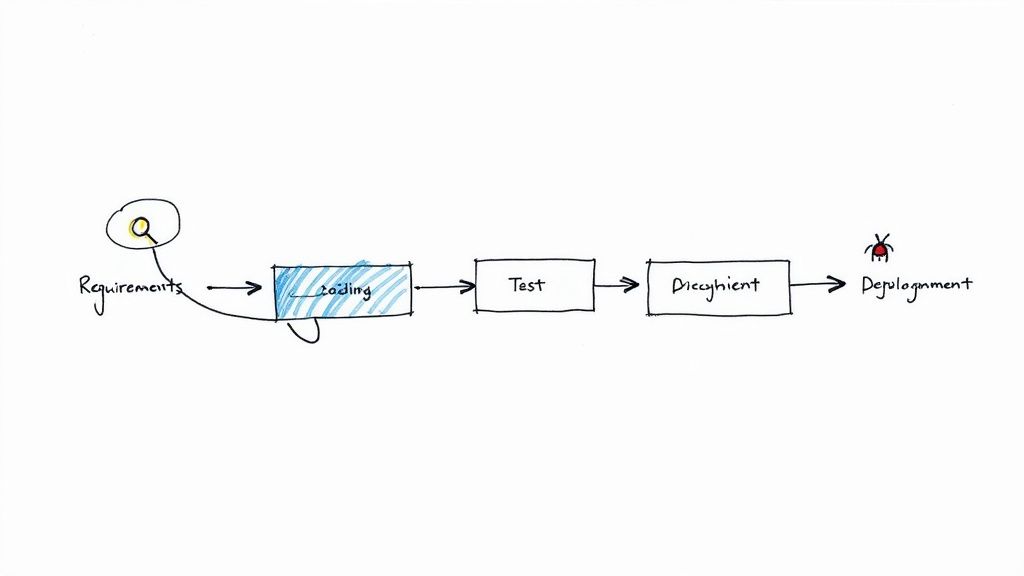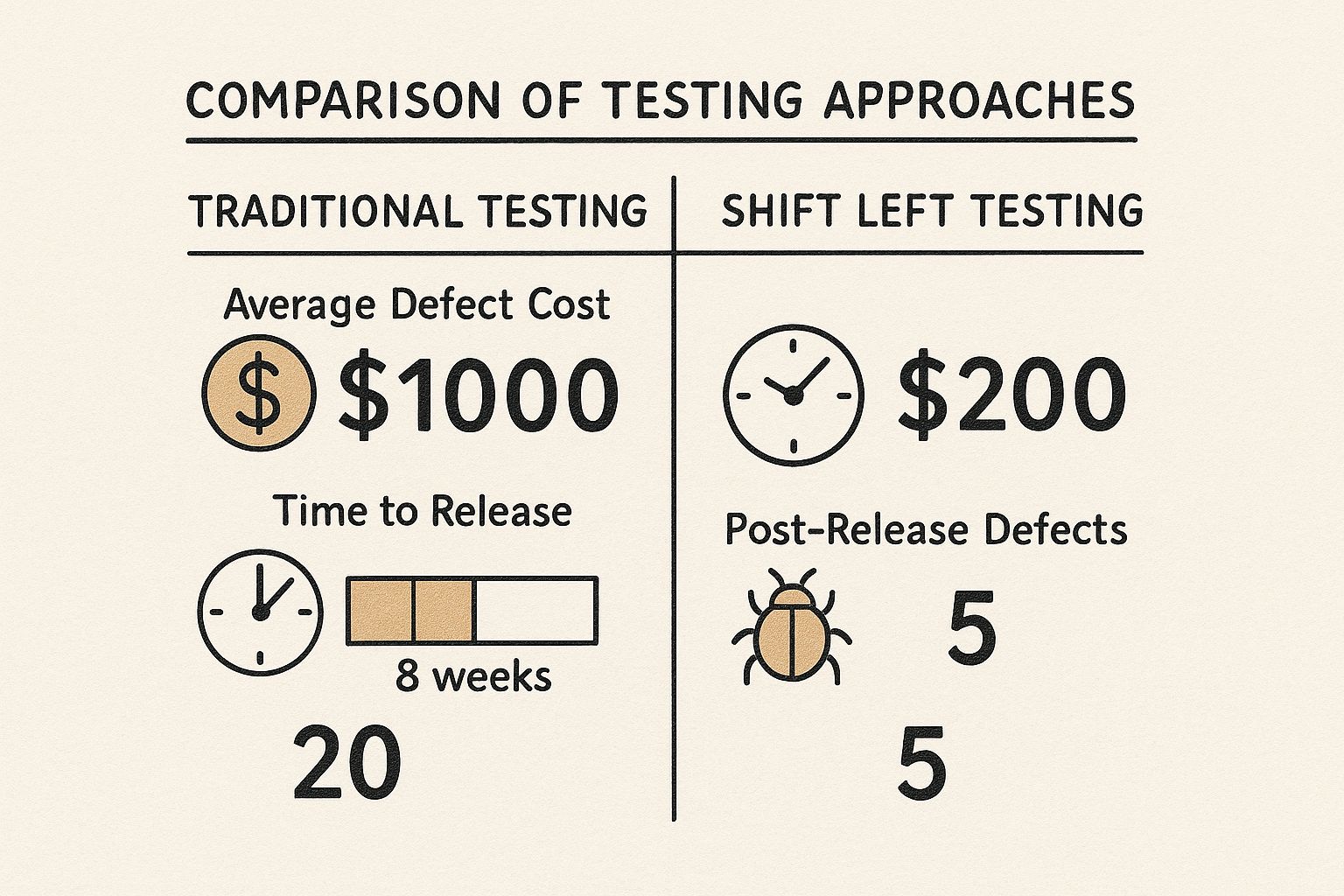What Is Shift Left Testing? Boost Quality & Save Costs

Demystifying Shift Left Testing: Breaking Down the Essentials

Shift left testing fundamentally changes how we think about testing in the software development lifecycle (SDLC). Instead of testing being a final hurdle before release, shift left testing integrates it from the very start of development. This proactive approach aims to catch bugs early, preventing small issues from becoming major headaches down the line. The result? A more efficient and streamlined development process.
This change in timing is key. Traditional testing often happened at the end of the development cycle, leading to expensive and time-consuming fixes when bugs were inevitably discovered late in the game. Shift left testing tackles this problem directly.
The impact of early bug detection is substantial. Shift left testing has become essential in modern software development, with early adoption seen in the automotive industry. The V-model of software development, frequently used in this sector, clearly demonstrates the benefits of shifting testing left. Developers can identify and address bugs before code is even committed, aligning perfectly with continuous integration and continuous deployment.
This leads to fewer bugs and better software quality. Early bug fixes are generally less expensive than those found later in the development cycle. The term "shift left" originates from a 2001 paper by Larry Smith, highlighting the importance of early testing to reduce bugs and costs. Explore this topic further
Understanding the Key Principles
Several core principles drive the effectiveness of shift left testing:
- Continuous Testing: Testing is an ongoing process, interwoven into each development stage.
- Collaboration: Developers and testers work hand-in-hand from the beginning, sharing responsibility for quality.
- Automation: Automated testing tools are crucial for efficient and consistent testing throughout the SDLC.
Benefits of Early Bug Detection
The advantages of early bug detection are numerous. It significantly reduces the cost of fixing errors, which can grow exponentially the longer they remain undetected. It also shortens development cycles by minimizing the need for extensive rework at the project's end. Teams deliver high-quality software faster and more efficiently.
Shift left testing also improves developer morale. Addressing issues early removes the pressure of last-minute bug fixes, leading to a more positive and productive environment. This contributes to higher quality code and increased project success.
The Evolution From Afterthought To Essential Strategy

Historically, testing was the final stage of the software development lifecycle (SDLC). It was often treated as an afterthought, tacked on at the end rather than integrated throughout the process. This late-stage approach often resulted in costly delays and budget overruns.
However, the software development industry has seen a major shift in this thinking. Shift left testing has evolved from a novel idea to a core principle of modern software development.
This transformation wasn't random. The growing complexity of software, combined with the demand for faster releases, made early and continuous testing not just a good idea, but a necessity. Think of building a house and only inspecting the foundation after the roof is finished. Discovering cracks at that point would mean expensive and time-consuming repairs. Shift left testing applies this same logic to software, ensuring a solid foundation from the beginning.
The Cost of Late-Stage Bugs
Finding bugs late in development can be incredibly expensive. According to the NIST, fixing defects in production can be 30 times more expensive than addressing them earlier. For security flaws, the cost can jump to 60 times more. These numbers highlight the financial advantages of shifting left.
This translates to more than just saving money. It also protects a company's reputation and builds stronger customer relationships.
Pivotal Moments In Testing Philosophy
Several key moments marked this change in how the industry views testing. Larry Smith's 2001 paper, which introduced the term "shift left," was a major turning point. The rise of Agile and DevOps methodologies, with their focus on continuous integration and continuous delivery, also fueled the adoption of shift left principles.
These practices emphasized integrating testing throughout the entire SDLC, fostering better collaboration between developers and testers.
Competitive Advantages In A Fast-Paced Market
Today, organizations that embrace shift left testing gain a significant edge. This method allows them to release software faster, with improved quality and fewer defects after release. This increased agility lets them respond more effectively to market shifts and changing customer needs.
Consequently, companies that resist this change often struggle to compete. Shift left testing is no longer optional; it's a requirement for success in modern software development.
Core Methodologies That Power Effective Shift Left Practice

The infographic above illustrates the positive impact of shift left testing on three key metrics: defect cost, time to release, and post-release defects. By shifting left, teams can significantly reduce costs, accelerate release cycles, and deliver higher quality products. Let's explore the core methodologies driving these improvements.
Test-Driven Development (TDD)
Test-Driven Development (TDD) is a crucial shift left methodology. In TDD, tests are written before the corresponding code. This approach encourages developers to think about the desired functionality upfront, resulting in more focused and testable code.
This proactive approach to quality ensures testability is baked in from the very beginning. The resulting comprehensive suite of unit tests provides continuous feedback throughout the development process, catching errors early.
Continuous Testing
Continuous Testing naturally follows TDD. It expands the scope of testing beyond unit tests, incorporating various testing types throughout the Software Development Life Cycle (SDLC). This constant validation helps identify integration issues and other defects early on.
Agile methodologies further enhance this process by weaving testing into each development stage. Agile/DevOps practices are a prime example of how continuous, iterative testing becomes integral to the entire software development lifecycle.
Service Virtualization
Service Virtualization is another powerful shift left technique. It simulates the behavior of dependent systems, enabling testing even when those systems aren't readily available or accessible. This eliminates delays caused by waiting for other teams or third-party services, streamlining the development pipeline.
Static Code Analysis
Finally, integrating static code analysis adds another layer of early defect detection. Static code analysis tools automatically scan code for potential vulnerabilities, style violations, and other problems before execution.
This proactive approach identifies code smells and potential bugs early, complementing dynamic testing efforts. The result is cleaner, more maintainable code with a reduced risk of accumulating technical debt.
To better understand the various approaches to shift left testing, let’s examine the following comparison table. It provides a detailed overview of each methodology’s key characteristics, ideal use cases, and implementation challenges.
Shift Left Testing Approaches Compared
| Testing Approach | Key Characteristics | Best Suited For | Implementation Challenges |
|---|---|---|---|
| Test-Driven Development (TDD) | Writing tests before code; focus on desired functionality | Projects requiring high reliability and maintainability | Requires a shift in development mindset; can be time-consuming initially |
| Continuous Testing | Integrating various testing types throughout the SDLC | Agile and DevOps environments; projects with frequent releases | Requires robust automation infrastructure; managing large test suites |
| Service Virtualization | Simulating dependent systems for early testing | Projects with complex dependencies; situations where access to dependent systems is limited | Setting up and maintaining virtualized environments |
| Static Code Analysis | Automated code scanning for potential issues before execution | Projects focusing on code quality and security; reducing technical debt | Requires selecting appropriate tools and integrating them into the workflow; interpreting and addressing findings |
This table highlights the strengths and weaknesses of each shift left testing approach. While TDD focuses on building quality from the start, Continuous Testing emphasizes ongoing validation. Service Virtualization tackles dependencies, and Static Code Analysis proactively identifies code issues. Choosing the right combination of these methods is crucial for maximizing the benefits of shift left testing.
The Business Case: Measuring Real ROI of Shift Left Testing

Beyond its technical advantages, shift left testing offers a compelling return on investment (ROI). This section explores the financial benefits organizations gain by adopting this approach. These benefits translate into tangible cost savings, greater efficiency, and happier customers.
The Exponential Cost of Bugs
A fundamental principle of shift left testing is early bug detection. The cost of fixing a bug rises dramatically the later it's discovered. Resolving a defect during the requirements phase, for example, might cost $100. That same bug, if found during production, could cost $10,000 or more.
Effective shift-left practices involve early usability testing. For a deeper dive into current usability testing methods, check out this helpful resource on Usability Test Methods.
This exponential cost increase highlights the financial wisdom of early testing. Identifying and fixing issues early minimizes rework and prevents costly delays. This results in significant cost savings throughout the project.
Accelerated Time-to-Market
Shift left testing significantly reduces time-to-market. By finding and addressing issues early, teams avoid extensive rework later. This translates to fewer delays, faster release cycles, and a quicker return on investment. This accelerated delivery provides a competitive advantage in today’s dynamic market.
Reducing Technical Debt
Technical debt grows when teams cut corners or delay addressing technical problems. Shift left testing helps reduce this debt by prioritizing quality from the outset. This proactive approach prevents small issues from becoming large, expensive problems.
Improving Customer Satisfaction
Ultimately, shift left testing leads to higher quality software. This directly improves customer satisfaction. Fewer bugs mean a better user experience, fostering customer loyalty and a positive brand image.
Measuring and Communicating the Benefits
To demonstrate the ROI of shift left testing, it's essential to measure and communicate the benefits effectively. Tracking metrics like the number of bugs found at each stage, the cost of fixing them, and the time to resolution offers quantifiable proof of its positive impact.
These metrics can be used to create a strong business case for continued investment in shift left initiatives. This justifies resource allocation and reinforces the value of early testing. By showcasing the positive financial impact, teams can gain support for the continued adoption and improvement of shift left practices.
Implementing Shift Left: Your Practical Roadmap to Success
Shift left testing means integrating testing from the very start of the software development lifecycle (SDLC). This approach helps find and fix bugs earlier, leading to higher quality software and faster delivery. This section offers a practical roadmap for bringing shift left testing into your organization. We'll cover how to assess your current testing, transition smoothly, and use tools to support this change.
Assessing Your Current Testing Landscape
Before diving into shift left testing, it's crucial to understand your current testing practices. Start by analyzing your existing testing workflows. Look for areas where testing is concentrated at the end of the development cycle. Identify bottlenecks and pain points in your current process. This assessment forms a baseline to measure improvements against.
Transitioning to Shift Left: A Gradual Approach
Shifting left doesn't require a complete system revamp. A phased approach is usually more effective. Begin with unit tests. Encourage developers to write unit tests for all new code and gradually add them to existing code. This helps catch bugs early and creates a foundation for continuous testing.
Next, build testing into your CI/CD pipeline. Tools like Mergify can automate this, ensuring tests run automatically with every code change. This automation is essential for continuous integration and continuous delivery.
Essential Tools for Shift Left Success
Several tools can make shift left testing easier. Static analysis tools automatically scan code for potential problems before it's even run. Unit testing frameworks help developers write and run unit tests efficiently. Continuous integration tools, like Mergify, automate testing within the CI/CD pipeline. Choosing the right tools is key to a streamlined workflow.
Addressing Cultural and Organizational Shifts
Shift left testing is more than just new tools; it requires a change in mindset. Encourage collaboration between developers and testers. Promote shared responsibility for quality across the entire development process. This collaborative environment is vital for successful adoption.
Define clear roles and workflows. Make sure developers understand their part in testing, and that testers are involved early in development. This clarity reduces confusion and promotes a seamless transition.
Tracking Progress and Measuring Success
Finally, track key metrics to understand the impact of shift left testing. Monitor the number of bugs found at each development stage. Track the time and money needed to fix those bugs. This data shows the return on investment (ROI) of shift left testing and supports continued focus on this practice.
To further clarify the differences between traditional and shift left testing, let's look at a comparison table:
This table contrasts traditional testing approaches with shift left testing across key dimensions:
| Aspect | Traditional Testing | Shift Left Testing | Business Impact |
|---|---|---|---|
| Timing | End of SDLC | Throughout SDLC | Faster time-to-market |
| Defect Detection | Late, expensive fixes | Early, inexpensive fixes | Cost savings |
| Collaboration | Limited | Extensive | Improved communication and shared responsibility |
| Quality | Reactive | Proactive | Higher quality software |
| Automation | Minimal | Extensive | Increased efficiency |
The table clearly shows how early and continuous testing with shift left impacts business outcomes positively. Shifting left allows organizations to create a more robust, efficient, and cost-effective development process.
Overcoming Resistance: Solving Common Shift Left Challenges
Shift left testing offers significant advantages, but it also presents implementation challenges. This section addresses common hurdles teams encounter when adopting shift left testing and offers practical solutions for a smoother transition and maximized benefits. Shift left testing can significantly contribute to achieving and maintaining regulatory compliance solutions, a crucial aspect of project success.
Addressing Developer Resistance
A common challenge is initial resistance from developers, who may perceive increased testing responsibilities as extra workload or outside their core expertise. To address this, emphasize the benefits of early bug detection for developers: less debugging time later, faster release cycles, and a more predictable development process.
Building a collaborative culture is key. Foster open communication and shared ownership of quality between developers and testers. Providing adequate training and support equips developers with necessary testing skills, empowering them to embrace shift left.
Overcoming Resource Constraints
Limited resources, both budget and personnel, can hinder shift left adoption. Building a strong business case for investing in automation tools is crucial. Highlight how automation reduces manual testing effort, leading to faster testing cycles and quicker time-to-market, ultimately reducing development costs.
Training existing staff on new testing techniques and tools can be more cost-effective than hiring. Explore online resources and internal training programs to enhance the team’s shift left skills.
Bridging Skill Gaps
A lack of testing expertise within the development team can be a significant roadblock. Targeted upskilling programs can address this. Identify specific skill gaps and provide tailored training in areas like test automation, different testing methodologies, and using specific testing tools.
Strategic hiring can supplement upskilling. Bringing in experienced testers to mentor and guide the development team can accelerate the adoption of shift left principles and best practices.
Integrating With Existing Workflows
Integrating shift left testing with existing workflows can be complex. Start with a small pilot project to test the new approach and gather feedback. Use this experience to refine processes before broader implementation.
Choose tools that integrate seamlessly with your current development environment to minimize disruption and facilitate adoption. Provide clear documentation and support to guide the team through workflow changes.
Maintaining Test Quality
As the number of tests increases with shift left, maintaining their quality is essential. Implement a robust test management system to organize and track tests, ensuring they remain relevant and effective. Regularly review and update tests to prevent them from becoming outdated.
Celebrating Successes
Acknowledge and celebrate successes. Highlight shift left’s positive impact on metrics like bug detection rates, time-to-market, and customer satisfaction. This reinforces the value of the approach and motivates continued adoption.
By proactively addressing these challenges, organizations can successfully implement shift left testing and realize its benefits: reduced costs, faster releases, improved software quality, and increased customer satisfaction. Shift left is a key strategy for achieving software development excellence.
Ready to streamline your development workflow and enhance code quality? Explore how Mergify can empower your team. Mergify simplifies and automates your pull request process, ensuring that testing is integrated seamlessly into your development lifecycle.





